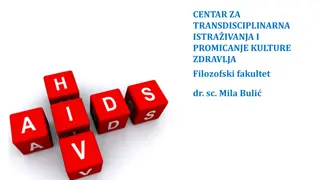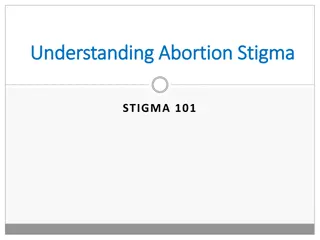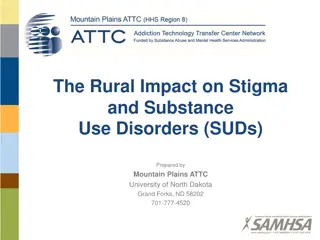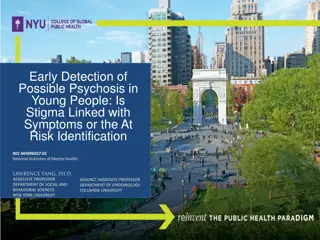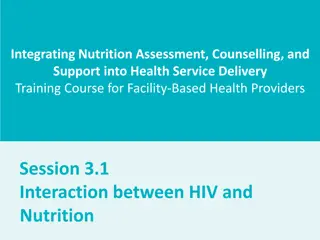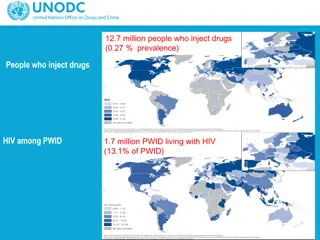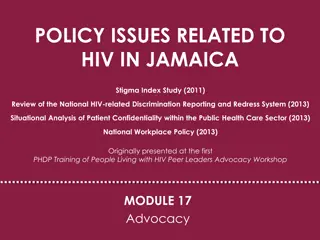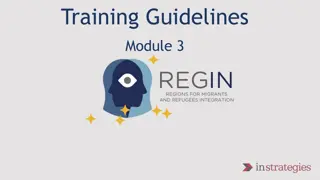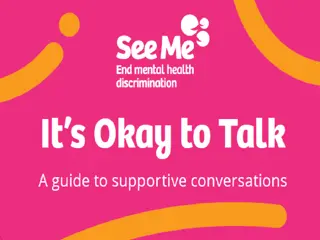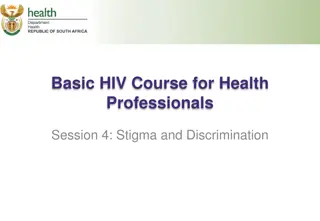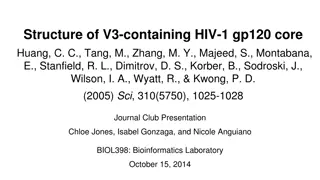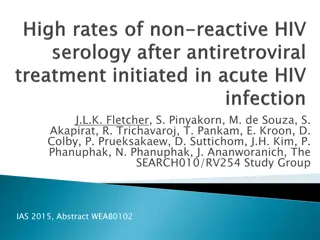Challenges in Addressing HIV Stigma and Discrimination
Despite a decline in stigma associated with HIV, discriminatory attitudes persist globally, impacting access to healthcare and social inclusion. Data reveals variances in attitudes towards people living with HIV across different regions and highlights the need to address discrimination within healthcare settings.
Download Presentation

Please find below an Image/Link to download the presentation.
The content on the website is provided AS IS for your information and personal use only. It may not be sold, licensed, or shared on other websites without obtaining consent from the author.If you encounter any issues during the download, it is possible that the publisher has removed the file from their server.
You are allowed to download the files provided on this website for personal or commercial use, subject to the condition that they are used lawfully. All files are the property of their respective owners.
The content on the website is provided AS IS for your information and personal use only. It may not be sold, licensed, or shared on other websites without obtaining consent from the author.
E N D
Presentation Transcript
PART II Barriers to ending AIDS
Stigma has declined Percentage of people who would not buy vegetables from a shopkeeper living with HIV, 2000 2008 compared to 2009 2016 100 90 80 70 60 Percent 50 40 30 20 10 0 Global Eastern and southern Africa Western and central Africa Caribbean Asia and the Pacific Eastern Europe and central Asia* 2000 2008 2009 2016 * Data for females respondents only. Data coverage of regional aggregates: global: 45 countries, 28% 2017 population coverage; Asia and the Pacific: 7 countries, 29% 2017 population coverage; Eastern and southern Africa: 12 countries, 71% 2017 population coverage; Western and central Africa: 16 countries, 91% 2017 population coverage; Caribbean: 6 countries, 88% 2017 population coverage; Eastern Europe and central Asia: 9 countries, 32% 2017 population coverage. Aggregates for Latin America, the Middle East and North Africa and western and central Europe and North America are not shown as data were only available from 2 countries in the region or less. Source: Population-based surveys, 2000 2016.
but discriminatory attitudes persist globally Percentage of men and women aged 15 49 years with discriminatory attitudes towards people living with HIV, countries with available data, 2013 2016 100 90 80 70 60 Percent 50 40 30 20 10 0 Kazakhstan* Mauritania Armenia Ethiopia Timor-Leste Nepal Angola VietNam* Uganda Burundi Zimbabwe Malawi Eswatini Would not buy vegetables from a shopkeeper living with HIV Think children living with HIV should not be able to attend school with children who are not living with HIV * Female respondents only. Source: Population-based surveys, 2013 2016.
Discrimination within health care Percentage of people living with HIV who experienced discrimination in health-care settings, countries with available data, 2012 2017 Algeria Morocco Mauritius Tajikistan Ukraine Kazakhstan Germany Paraguay Gabon Health-care professional ever told other people about their HIV status without their consent Michigan, United States ofAmerica Greece Ukraine Kyrgyzstan CostaRica Denied health services because of their HIV status at least once in the past 12 months United Republic of Tanzania (Dar esSalaam) Portugal Belize Zimbabwe Democratic Republic of theCongo Congo Bangladesh Uganda Honduras Nicaragua Lesotho Mozambique SouthAfrica Botswana Senegal Liberia C ted'Ivoire Burundi VietNam Malawi Ghana SierraLeone Yemen 1 Respondents had been denied health care in the previous 12 months due to the HIV status, forced to submit to a medical or health procedure in the previous 12 months due to their HIV status (including HIV testing) or had a health-care professional disclose their HIV status without consent. 2 These women reported that a health-care professional had advised them not to have a child due to their HIV-positive status, that they had been told that access to antiretroviral treatment was conditional on the use of certain forms of contraception, or that they had been denied sexual and reproductive health services in the previous 12 months due to their HIV status. 0 10 20 30 40 50 60 70 80 90 100 Per cent Source: People Living with HIV Stigma Index surveys, 2012 2017.
An infringement of the right to health Percentage of key populations who reported having avoided health-care services in the past 12 months due to stigma and discrimination, countries with available data, most recent data, 2013 2017 100 80 60 Percent 40 20 0 Bangladesh Mauritius Morocco Bangladesh Cameroon Cameroon Seychelles Mauritius Mauritius C te d'Ivoire Morocco C te d'Ivoire Myanmar Paraguay Myanmar Myanmar Myanmar Thailand Democratic Republic Paraguay Paraguay Seychelles Lao People s Lesotho Zimbabwe Zimbabwe Lesotho Senegal Lao People s Democratic Republic Algeria Algeria Serbia Serbia Guinea Uganda Cuba Cuba Nepal Fiji Fiji People who inject drugs Gay men and other men who have sex with men Sex workers Transgender persons Avoided healthcare Avoided HIVtesting Avoided HIV-relatedcare Avoided HIV treatment Source: Integrated biological and behavioural surveys, 2013 2017..
Young women at high risk of HIV Number of new HIV infections among young people (aged 15 24 years), by sex, eastern and southern Africa and western and central Africa, 2000 2017 Eastern and southern Africa Western and Central Africa 500000 500000 450000 450000 400000 400000 350000 350000 Number of new HIV infections Number of new HIV infections 300000 300000 250000 250000 200000 200000 150000 150000 100000 100000 50000 50000 0 0 2000 2001 2002 2003 2004 2005 2006 2007 2008 2009 2010 2011 2012 2013 2014 2015 2016 2017 2000 2001 2002 2003 2004 2005 2006 2007 2008 2009 2010 2011 2012 2013 2014 2015 2016 2017 Females Males Source: UNAIDS 2018 estimates.
Intimate partner violence: a global issue Percentage of ever-married or partnered women aged 15 49 years who experienced physical and/or sexual violence by an intimate partner in the past 12 months, 2012 201 Western and central Europe 6.5% Caribbean 12.4% Asia and the Pacific 21.2% Western and central Africa 19.4% Eastern and southern Africa 21.0% Global 18.0% 0 12% 13 24% 25 37% 38 50% Note: Data for all countries in western and central Europe except Turkey are for women aged 18 49 years. Data coverage of regional aggregates: Global: 74 countries, 49% of 2017 population; Asia and the Pacific: 11 countries, 47% of 2017 population; Eastern and southern Africa: 14 countries, 89% of 2017 population; Western and central Africa: 8 countries, 68% of 2017 population; Caribbean: 4 countries, 90% of 2017 population; Western and central Europe: 29 countries, 60% of 2017 population. Aggregates for eastern Europe and central Asia, Latin America, North America and the Middle East and North Africa are not shown as data available reflected less than 40% of the regional population in 2017. Source: Population-based surveys, 2012 2017. United Nations Statistics Division, SDG Indicators Global Database. Accessed 29 June 2018 (https://unstats.un.org/sdgs/indicators/database/).
Frequent victims of violence (1) Percentage of key populations who reported experiencing physical and sexual violence, countries with available data, 2012 2015 100 80 60 Percent Female sex workers 40 20 0 Johannesburg, SouthAfrica* Ghana Guyana Haiti India* Mauritius* Gambia Somalia DemocraticRepublic Colombo, SriLanka Burundi Nairobi,Kenya* of theCongo Eswatini Djibouti Liberia Nepal BurkinaFaso Cameroon Yaound ,Cameroon Tbilisi,Georgia Benin Pakistan Maseru,Lesotho SouthAfrica* Physicalviolence Sexualviolence 100 80 Gay men and other men who have sex with men 60 Percent 40 20 0 Nairobi,Kenya* Georgia Eswatini Angola Burundi Colombo, SriLanka C ted'Ivoire Mauritius Togo Lilongwe, Malawi Maseru,Lesotho Haiti Yaound ,Cameroon Haiti BurkinaFaso Pakistan Kampala,Uganda Montenegro India Cameroon Liberia Gambia * Experienced in the past 12 months. Source: Integrated biological and behavioural surveys, 2014 2015.
Frequent victims of violence (2) Percentage of key populations who reported experiencing physical and sexual violence, countries with available data, 2012 2015 People who inject drugs Transgender people 100 100 90 90 80 80 70 70 60 60 Percent Percent 50 50 40 40 30 30 20 20 10 10 0 0 Pattaya, Thailand* Pakistan Rio de Janeiro, Brazil Colombo, Sri Lanka Nairobi, Kenya India* Pakistan LIberia Physicalviolence Sexualviolence Source: Integrated biological and behavioural surveys, 2014 2015. *Experienced in the past 12 months.
HIV and tuberculosis in prisons Global and regional prevalence of HIV among prison inmates, data from 2005 to 2015 0 1.0% 1.1 5.0% 5.1 10.0% 10.1 15.0% 15.1 20.0% >20.0% Data not available Source: Dolan K, Wirtz AL, Moazen B, Ndeffo-mbah M, Galvani A et al. Global burden of HIV, viral hepatitis, and tuberculosis in prisoners and detainees. The Lancet. 2016;388(10049):1089 1102; Global AIDS Monitoring, 2018.
Forcing gay men and other men who have sex with men into hiding Criminalization of same-sex sexual acts, global, 2017 Death penalty Imprisonment or no penalty specified Data not available Laws penalizing same-sex sexual acts have been decriminalized or never existed, or no specific legislation Source: 2017 National Commitments and Policy Instrument.
Criminalization of any aspect of sex work, global, 2017 Criminalization of sex work, global, 2016 Any criminalization or punitive regulation of sex work Sex work is not subject to punitive regulations or is not criminalized Issue is determined/differs at subnational level Data not available Source: 2017 National Commitments and Policy Instrument.
A barrier to reaching people who inject drugs Criminalization of drug use, global, 2016 Possession of drugs for personal use is specified as a criminal offence, or drug use or consumption is a specific offence in law Compulsory detention for drug offences Possession of drugs for personal use is specified as a non-criminal offence Data not available
Fuelling stigma, discrimination and fear of people living with HIV Countries with laws that criminalize or allow for prosecutions related to the transmission or non-disclosure of HIV infection, or exposure to HIV 46% 69% 100% 62% 56% 45% 100% 100% Eastern and southern Africa (n = 16) Asia and thePacific (n = 24) Eastern Europe and central Asia (n = 15) Latin America (n = 13) Caribbean (n = 9) Middle East and NorthAfrica (n = 11) Western and central Africa (n = 15) Western and central Europe and North America (n = 5) Reporting countries Countries with laws that criminalize or that allow for prosecutions related to the transmission or non-disclosure of HIV infection, or exposure to HIV Source: National Commitments and Policy Instrument, 2017.
Discouraging adolescents from accessing services Countries with age of consent laws to access sexual and reproductive health services, 2018 52% 53% 92% 59% 90% 58% 61% 57% Eastern and southern Africa Asia and thePacific Eastern Europe and central Asia Latin America Caribbean Middle East and NorthAfrica Western and central Africa Western and central Europe and North America Reporting countries Countries with laws requiring parental consent for adolescents to access sexual and reproductive health services Source: 2017 and 2018 National Commitments and Policy Instrument.
People living with HIV struggling to claim their rights Percentage of people living with HIV who reported their rights were abused in the past 12 months who sought legal redress, countries with available data, 2011 2016 100 90 80 70 60 Percent 50 40 30 20 10 0 Cameroon Portugal Republic ofMoldova Nepal Mauritius of theCongo Burundi DemocraticRepublic Malawi Nicaragua Uganda Eswatini Germany Malaysia Nigeria CostaRica Honduras Senegal Zimbabwe Belize Reported rights as a person living with HIV were abused in the past 12 months and tried to get legal redress and matter was dealt with or was still inprocess Reported rights as a person living with HIV were abused in the past 12 months and tried to get legal redress and the process had not started in the past 12 months or the process had started but nothing happened Reported rights as a person living with HIV were abused in the past 12 months and did not try to get legal redress Source: People Living with HIV Stigma Index surveys, 2011 2016.
Putting in place mechanisms to empower people living with HIV Percentage of reporting countries that have mechanisms in place to promote access to justice, by region, 2017 100 90 80 70 60 Percent 50 40 30 20 10 0 Asia and the Pacific (n = 21) Caribbean (n = 9) Eastern Europe and central Asia (n = 10) Eastern and southern Africa (n = 18) Latin America (n = 15) Middle East and North Africa (n = 9) Western and central Africa (n = 14) Western and central Europe and North America (n = 7) Legal aid systems applicable to HIV casework Pro bono legal services provided by private law firms Legal services by legal clinics Community paralegals Other None Source: 2017 National Commitments and Policy Instrument.
Help is expensive and hard to find Number of countries where civil society and other nongovernmental partners report barriers to accessing accountability mechanisms, global, 2017 90 80 70 Number of countries 60 50 40 30 20 10 0 Mechanisms arenot HIV-sensitive Mechanisms do notfunction Affordability constraints Awareness/knowledge of mechanism use islimited Source: 2017 National Commitments and Policy Instrument.
Rising inequality almost everywhere Share of national income accounted for by top 10% of earners, select regions and countries, 1980 2016 100 90 80 70 60 Percent 50 40 30 20 10 0 1980 1982 1984 1986 1988 1990 1992 1994 1996 1998 2000 2002 2004 2006 2008 2010 2012 2014 2016 Middle East Brazil Sub-Saharan Africa China India United States of America and Canada Russian Federation Europe Source: World inequality report 2018. Washington (DC): World Bank; 2018 (http://wir2018.wid.world).
High out-of-pocket spending in all regions Out-of-pocket payments by households as percentage of total current health expenditure, regional average, 2015 50 45 40 35 30 25 20 15 10 5 0 Percent Western and central Europe and North America Asia and the Pacific Middle East and North Africa Eastern and southern Africa Latin America Caribbean Western and central Africa Eastern Europe and central Asia Source: Global Health Expenditure Database. World Health Organization. http://apps.who.int/nha/database/Select/Indicators/en (accessed 1 June 2018).
Momentum on eliminating user fees Health-care user fees, sub-Saharan Africa, 2000 and 2017 11% 10% 2017 2000 90% 89% Countries with user fees in the past Countries with no user fees in the past Countries that have made efforts to eliminate user fees Countries that have not made efforts to eliminate user fees Source: Cotlear D, Rosemberg N. Going universal in Africa: how 46 African countries reformed user fees and implemented health care priorities. Universal Health Care Coverage Series No. 26. Washington (DC): World Bank; 2018.
Multiple actions to reduce risk, vulnerability and poverty Components of social protection systems SOCIAL PROTECTION SOCIAL INSURANCE AND LABOUR MARKET POLICY Contributory schemes (pensions, work incidence protection, etc.), labour market policies protection, etc.), labour market policies SOCIAL INSURANCE AND LABOUR MARKET POLICY Contributory schemes (pensions, work incidence SOCIAL SAFETY NETS (OR SOCIALASSISTANCE) Non-contributory transfers, fee walvers, etc. Unconditional transfers Unconditional transfers SOCIAL SAFETY NETS (OR SOCIAL ASSISTANCE) Non-contributory transfers, fee walvers, etc. Social pensions, public works Conditional cash transfers, school feeding Outside social protection e.g. microcredit SOCIAL SERVICES FOR HEALTH, EDUCATION Access to social services for education, health,nutrition, unemployment, maternity, survivor benefits nutrition, unemployment, maternity, survivor benefits SOCIAL SERVICES FOR HEALTH, EDUCATION Access to social services for education, health, Outside social protection e.g. teacher training Source: State of social safety nets. Washington (DC): World Bank; 2015.
Policies for HIV-sensitive social protection HIV-sensitivity of social protection strategies, policies or frameworks in Fast-Track countries, 2018 Has an approved social protection strategy, policy or framework that is being implemented Refers to HIV Recognizes people living with HIV as key beneficiaries Recognizes key populations as key beneficiaries Recognizes adolescent girls and young women as key beneficiaries Recognizes people affected by HIV as key beneficiaries Addresses the issue of unpaid care work in the context of HIV Country Angola Botswana Brazil Cameroon Chad China C te d'Ivoire Democratic Republic of the Congo Eswatini Ethiopia Ghana Haiti India Indonesia Iran (Islamic Republic of) Jamaica Kenya Lesotho Malawi Mali Mozambique Myanmar* Namibia* Nigeria Pakistan South Africa South Sudan Uganda United Republic of Tanzania Ukraine Viet Nam Zambia Zimbabwe Russian Federation United States of America Yes No Data not available Source: 2018 National Commitments and Policy Instrument.
Broad benefits of cash plus care Developmental benefits of cash transfers and supportive care interventions for adolescents (aged 10 18 years), South Africa, 2009 2012 HIV risk behaviour 30 25 Violence perpetration Sexual violence and exploitation 20 20 25 15 Percent 15 15 Percent Percent 15 10 10 10 5 0 5 5 0 0 None Care Cash Cash+ Care None Care Cash Cash+ Care None Care Cash Cash+Care None Care Cash Cash+Care Mental health problem Teen pregnancy School non-enrolment Hunger 60 50 40 30 20 10 0 60 50 40 30 20 10 0 10 8 15 10 Percent Percent Percent Percent 6 4 2 0 5 0 None Cash None Care Cash Cash+ Care No cash Cash None Care Cash Cash+ Care Boys Girls Source: Cluver LD, Orkin M, Meinck F, Boyes ME, Yakubovich AR, Sherr L et al. Can social protection improve Sustainable Development Goals for adolescent health? PLoS One. 2016;11(10):e0164808.



